The Samsung 960 Pro (2TB) SSD Review
by Billy Tallis on October 18, 2016 10:00 AM ESTMixed Random Read/Write Performance
The mixed random I/O benchmark starts with a pure read test and gradually increases the proportion of writes, finishing with pure writes. The queue depth is 3 for the entire test and each subtest lasts for 3 minutes, for a total test duration of 18 minutes. As with the pure random write test, this test is restricted to a 16GB span of the drive, which is empty save for the 16GB test file.
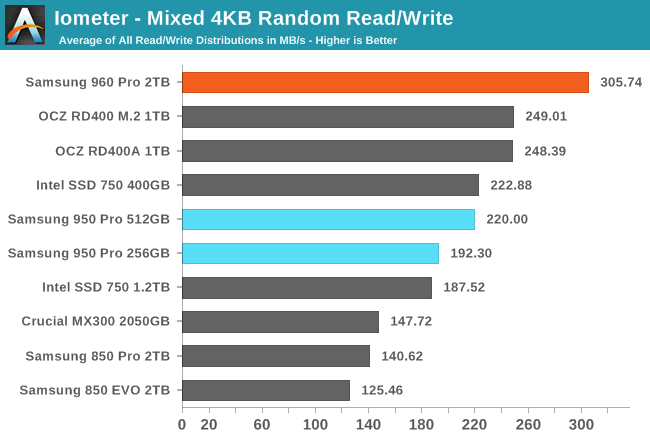
The Samsung 950 Pro never had a clear lead on the mixed random I/O test, and then the OCZ RD400 raised the bar. The 960 Pro is 22% faster than that and is alone at the top.
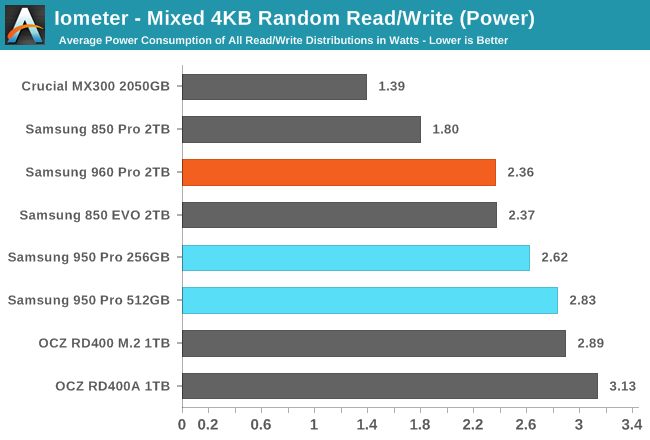
The 960 Pro has power draw comparable to the SATA SSDs that are less than half the speed, and clearly lower than the power draw of the other NVMe SSDs.
 |
|||||||||
Most of these drives spend at least the first half of the test below 200MB/s and bring their score up with a strong finish of fast random writes. The 960 Pro hits 200MB/s in the second phase and continues increasing throughout the test, then finishes with a random write speed that beats even the Intel SSD 750.
Mixed Sequential Read/Write Performance
The mixed sequential access test covers the entire span of the drive and uses a queue depth of one. It starts with a pure read test and gradually increases the proportion of writes, finishing with pure writes. Each subtest lasts for 3 minutes, for a total test duration of 18 minutes. The drive is filled before the test starts.
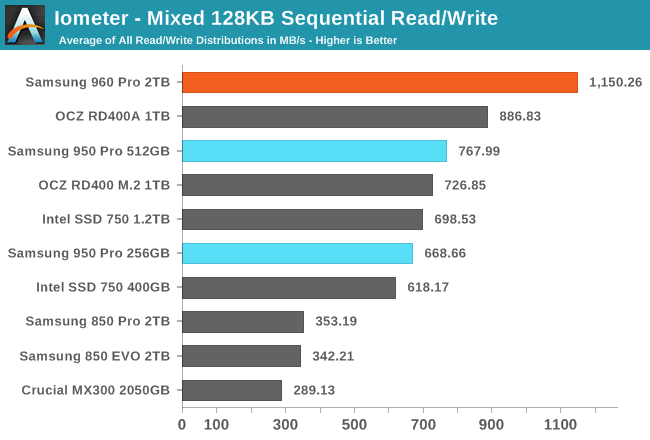
The 960 Pro's mixed sequential speeds are a big jump over any previous drive, with about a 30% advantage over the OCZ RD400A and over three times the performance of any SATA drive.
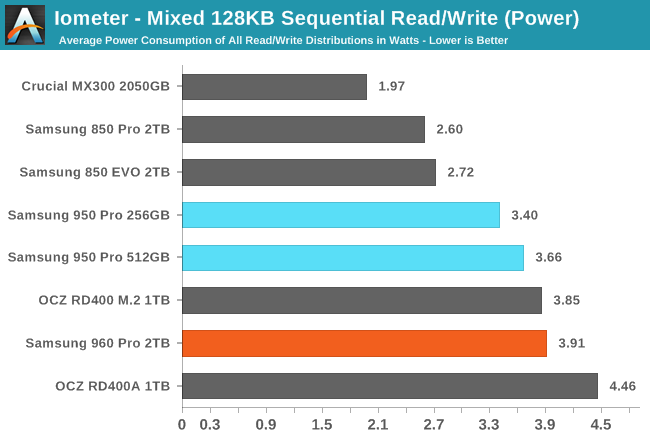
The 960 Pro's power consumption is about the same as the OCZ RD400 and slightly higher than the 950 Pro, so it is only about 15% more efficient than any other drive.
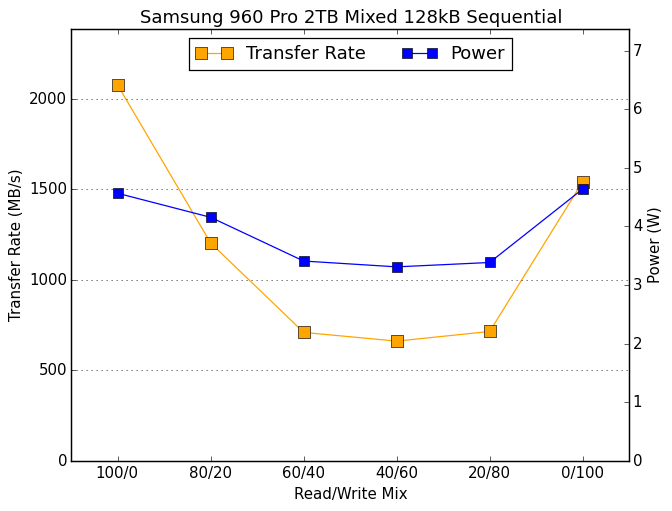 |
|||||||||
At the beginning and end of the test the 960 Pro appears to be thermally limited with power consumption above 4W. In the middle of the test where it is typical to see the lowest performance, the 960 Pro doesn't even come close to dropping down to SATA speeds. Its nearest competitor in performance (the OCZ RD400) has much worse performance during the early read-heavy parts of the test.










72 Comments
View All Comments
leexgx - Tuesday, October 25, 2016 - link
the problem with windows 10 when using as a benchmark system is you got to make sure automatic maintenance is disabled and windows update is disabled or it mess the results up (i have 2 laptops and both of them go nuts when screen turns off on win10{fan revved up and lots of SSD activity)i would personally stick with windows 7 or 8 as they are more predictable
if using windows 8 and 10 you need to disable the idle maintenance auto task (set windows update to never check) and windows 10 you have to disable the windows update service as it can mess up benchmark results (or if using windows 10 pro use GPedit to set windows update to ask before downloading, note pressing check or download actually means download and install on windows 10 pro)
Badelhas - Tuesday, October 18, 2016 - link
If I replace my Vertex 3 120Gb Sata3 SSD with this one and use my PC for normal tasks like web browsing and gaming, will I notice any difference? Thats the real question to me.Cheers
DanNeely - Tuesday, October 18, 2016 - link
The biggest one will be being able to have all yours games on SSD instead of just 1 or 2. Even a cheap SSD is fast enough that IO rarely is a major bottleneck in day to day consumer use.phobos512 - Tuesday, October 18, 2016 - link
For the money you will spend, you will not notice a significant difference. If the rest of your system is of the same vintage as the SSD you're replacing, that will be even more true.phobos512 - Tuesday, October 18, 2016 - link
And here's the evidence.https://cdn.arstechnica.net/wp-content/uploads/sit...
https://cdn.arstechnica.net/wp-content/uploads/sit...
https://cdn.arstechnica.net/wp-content/uploads/sit...
Amoro - Tuesday, October 18, 2016 - link
There's a typo in the form factor for 960 drives, "Sngle-sided". Also, if the form factor is the same for both drives shouldn't the cell be merged?Does this make the 950 Pro obsolete at this point too? At least for the 512GB version.
Billy Tallis - Tuesday, October 18, 2016 - link
Thanks. I fixed the typo, but left the two cells separate and split the PCIe interface so that there's an uninterrupted vertical line separating the old drives from the new.Once the 512GB 960 Pro is widely available and once Samsung delivers the drivers for it, there should be no reason to get the 512GB 950 Pro. I do hope to confirm that directly by testing a 512GB 960 Pro against the 950 Pro, but sample supplies have been pretty limited for this launch. The 256GB 950 Pro won't have a direct successor, but if the 960 EVO does what it's supposed to it should offer better real-world performance at a much lower price.
TheinsanegamerN - Tuesday, October 18, 2016 - link
I'd say price would be a big one. If you can get the 950 pro for $100 less then the 960 pro of the same size, unless you need all that speed the 950 pro would be a better deal.Swede(n) - Tuesday, October 18, 2016 - link
How was the 960 Pro connected during the test?On the Asus Z97 mobos M.2 connector that shares bandwidth Sata Express #1?
If so, is it recommended to unplug any other Sata drive from this Sata port #1 and use a separate Sata port for that device (for not loosing performance under heavy workload where multiple SSD-drives are in use?
Or was the 960 Pro connected to a PCIE 3.0 via adapter?
Please explain this and the possible benefits for one or the other, consider a hefty game GPU connected to PCIE 3.0 x16 slot on a similar mobo (Asus Z97 Deluxe).
Sincerley from Sweden
Billy Tallis - Tuesday, October 18, 2016 - link
The SSD testbed doesn't have a discrete GPU, so all PCIe SSDs are tested in the PCIe 3.0 x16 slot. There's a riser card with the power measurement circuitry between the SSD and the motherboard. M.2 PCIe SSDs are tested in a simple passive PCIe x4 to M.2 adapter card which is plugged in to the power measurement riser card. I'll also be testing the 960 Pro with the Angelbird Wings PX1 adapter and heatsink as I dig deeper into its thermal performance.